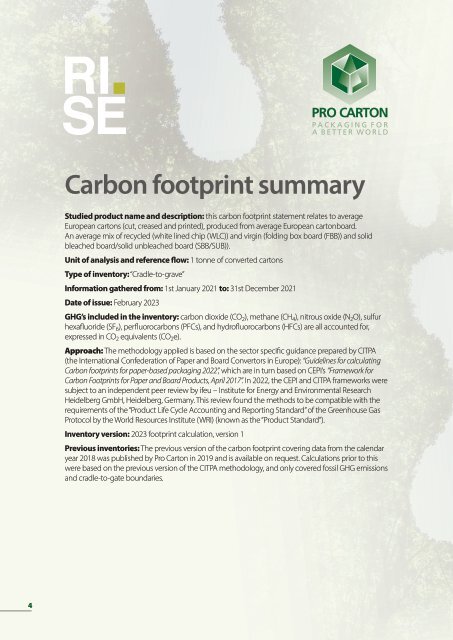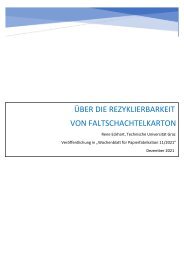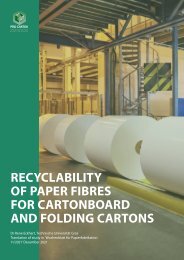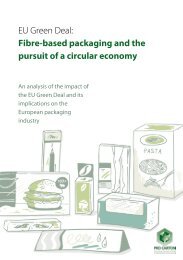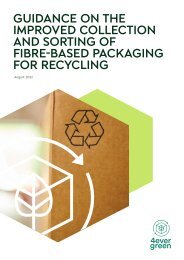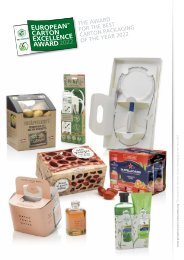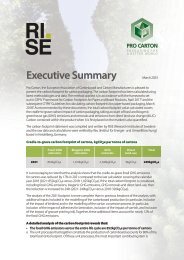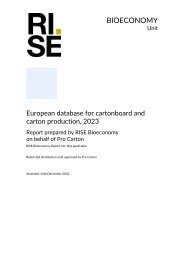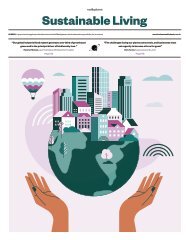You also want an ePaper? Increase the reach of your titles
YUMPU automatically turns print PDFs into web optimized ePapers that Google loves.
RI<br />
SE<br />
<strong>Carbon</strong> footprint summary<br />
Studied product name and description: this carbon footprint statement relates to average<br />
European cartons (cut, creased and printed), produced from average European cartonboard.<br />
An average mix <strong>of</strong> recycled (white lined chip (WLC)) and virgin (folding box board (FBB)) and solid<br />
bleached board/solid unbleached board (SBB/SUB)).<br />
Unit <strong>of</strong> analysis and reference flow: 1 tonne <strong>of</strong> converted cartons<br />
Type <strong>of</strong> inventory: “Cradle-to-grave”<br />
Information gathered from: 1st January 2021 to: 31st December 2021<br />
Date <strong>of</strong> issue: February <strong>2023</strong><br />
GHG’s included in the inventory: carbon dioxide (CO 2 ), methane (CH 4 ), nitrous oxide (N 2 O), sulfur<br />
hexafluoride (SF 6 ), perfluorocarbons (PFCs), and hydr<strong>of</strong>luorocarbons (HFCs) are all accounted for,<br />
expressed in CO 2 equivalents (CO 2 e).<br />
Approach: <strong>The</strong> methodology applied is based on the sector specific guidance prepared by CITPA<br />
(the International Confederation <strong>of</strong> Paper and Board Convertors in Europe): “Guidelines for calculating<br />
<strong>Carbon</strong> footprints for paper-based packaging 2022”, which are in turn based on CEPI’s “Framework for<br />
<strong>Carbon</strong> <strong>Footprint</strong>s for Paper and Board Products, April 2017”. In 2022, the CEPI and CITPA frameworks were<br />
subject to an independent peer review by ifeu – Institute for Energy and Environmental Research<br />
Heidelberg GmbH, Heidelberg, Germany. This review found the methods to be compatible with the<br />
requirements <strong>of</strong> the “Product Life Cycle Accounting and Reporting Standard” <strong>of</strong> the Greenhouse Gas<br />
Protocol by the World Resources Institute (WRI) (known as the “Product Standard”).<br />
Inventory version: <strong>2023</strong> footprint calculation, version 1<br />
Previous inventories: <strong>The</strong> previous version <strong>of</strong> the carbon footprint covering data from the calendar<br />
year 2018 was published by Pro <strong>Carton</strong> in 2019 and is available on request. Calculations prior to this<br />
were based on the previous version <strong>of</strong> the CITPA methodology, and only covered fossil GHG emissions<br />
and cradle-to-gate boundaries.<br />
Biogenic carbon emissions and removals: It might be expected that the overall biogenic flows <strong>of</strong><br />
CO 2 equivalents across the life cycle (including those flows leaving the system as carbon contained in<br />
the recovered fibres) would add up to close to zero (i.e. that the biogenic carbon entering the system<br />
is completely balanced with the biogenic carbon leaving the system). <strong>The</strong> fact that there is not be an<br />
exact balance reflects some <strong>of</strong> the difficulties in quantifying biogenic GHG emissions and removals.<br />
<strong>The</strong> imbalance reflects two aspects <strong>of</strong> the calculations:<br />
1) As cartons achieve a high recycling rate, this means that a proportion <strong>of</strong> the original carbon<br />
removals (which are contained in the product when it is first placed on the market) are carried<br />
through to the life cycle <strong>of</strong> subsequent products outside the boundaries <strong>of</strong> this analysis. In line<br />
with the CITPA methodology, a cut-<strong>of</strong>f method is applied for the share <strong>of</strong> the material that is sent<br />
for recycling. This means that the impacts associated with reprocessing the cartons sent for<br />
recycling and any credits associated with avoided production <strong>of</strong> virgin materials are allocated to the<br />
products which incorporate the recycled content, rather than to the carton system. It also means<br />
that the emissions from the final waste management <strong>of</strong> the products produced from recycled<br />
cartons are outside <strong>of</strong> the boundaries <strong>of</strong> this analysis.<br />
2) <strong>The</strong>re may be differences in the assumptions in the background data regarding the carbon content<br />
(and therefore the biogenic GHG removals) <strong>of</strong> wood and wood chips compared to the carbon<br />
content <strong>of</strong> bi<strong>of</strong>uels used at the mill and the carbon content <strong>of</strong> paper in the energy recovery<br />
processes (and therefore the biogenic emissions arising from these processes).<br />
<strong>The</strong>refore, the results calculated and presented relating to biogenic GHG emissions and removals<br />
should be considered not as an accurate mapping <strong>of</strong> the flows but as informative <strong>of</strong> where in the<br />
life cycle biogenic removals and emissions occur and the likely scale <strong>of</strong> these compared to fossil<br />
GHG emissions and removals.”<br />
Results:<br />
<strong>The</strong> table below summarises the cradle-to-gate and cradle-to-grave emissions and removals,<br />
according to the category <strong>of</strong> emissions/removals i.e., according to fossil GHG emissions, biogenic<br />
GHG emissions, GHG removals and emissions due to direct land-use. <strong>The</strong> table below also<br />
shows that total, which is the sum <strong>of</strong> all categories <strong>of</strong> emissions and removals. <strong>The</strong> chart overleaf<br />
provides the breakdown <strong>of</strong> each category <strong>of</strong> emissions and removals according to the CEPI 10<br />
toes classification.<br />
Boundaries<br />
considered<br />
Cradle-to-gate total<br />
Cradle-to-grave total<br />
Fossil<br />
emissions<br />
kgCO 2 e/<br />
tonne <strong>of</strong><br />
cartons<br />
Biogenic<br />
emissions<br />
kgCO 2 e/<br />
tonne <strong>of</strong><br />
cartons<br />
Removals<br />
kgCO 2 e/<br />
tonne <strong>of</strong><br />
cartons<br />
Direct<br />
land-use<br />
kgCO 2 e/<br />
tonne <strong>of</strong><br />
cartons<br />
Total<br />
kgCO 2 e/<br />
tonne <strong>of</strong><br />
cartons<br />
929 828 -1,619 9 148<br />
852 1,014 -1,626 9 249<br />
4 5


